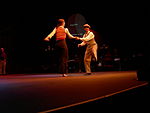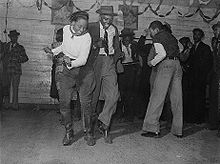Swing (dance)
| swing | |
|---|---|
 Peter Loggins and Mia Goldsmith dance the swing, 2007 |
|
| Technology: | unclassified |
| Type: | Couple dance , ballroom dancing |
| Music: |
Swing , big band , jump blues , also rock 'n' roll , blues |
| Time signature : | 4 / 4 -stroke (with exceptions) |
| Tempo: | ~ 20-60 + TPM |
| Origin: | United States |
| Creation time: | 1920s , 1930s , 1940s |
| List of dances | |

With Swing or Jitterbug an entire family is called dances, the end of the 1920s in the United States have emerged. The 1930s and 1940s can be seen as the heyday. Most of these dances are danced to swing music , but some of these dances only emerged from the swing to other music.
history
Swing is a rhythm that was formed from the black Afro rhythms of the Yoruba and Bantu and white marching music from the European immigrants, brought to the USA by the slaves who were abducted from Africa , and is predominant in all older forms of jazz music. The dance originated in the great ballrooms of New York City in the 1920s to the music of the big bands , who developed jazz music into orchestral swing music .
The energy of the dance, the jazz-typical improvisation and the openness to other musical and dance influences has led to a wide spectrum of typical movement elements, which continues to develop and expand today. The original variant of the dance comes from the Savoy Ballroom in the New York borough of Harlem and was known as Lindy Hop or Savoy-Style Swing. With the further spreading influences of other dances like Shag were added.
The best-known variant is the Hollywood style swing. It was danced primarily for the film industry in Hollywood and is also called the Dean Collins style after its first representative . Created around the turn of the 1940s / 50s, it was the white counterpart to the "black" Savoy style. It was important to get as much attention as possible; In other words, show elements were increasingly used, the dance became more extroverted and lost much of its original character.
As popular music developed from swing to rhythm and blues and the beginnings of rock 'n' roll and the beginnings of a media-supported pop culture emerged in the USA, more and more teenagers discovered dance and adapted it to the new musical styles. The media and the white population in particular also called the swing dance jitterbug. The GIs brought him to Europe during and after World War II . Here, under the influence of the somewhat different sound of the European dance bands and the dancing skills of the European youth, the boogie-woogie developed , for which the Hollywood style was probably the more important role model. These are newer variations of the swing dances.
With rock 'n' roll, disco culture and the decline of big bands, swing lost its popularity. Remnants were in the East and West Coast Swing in the USA, in the Ceroc / LeRoc / Roc in France and Great Britain and in the Bugg in Sweden. Also in the jive , one of the five Latin American dances of the world dance program , some of the basic elements of swing were standardized for European tournament dance. Since around 1985 there has been a Lindy Hop revival that starts in Sweden from Sweden. One of the annual international swing highlights, a five-week swing workshop in Herräng , Sweden, also takes place there.
Music and rhythm
The basic steps of swing dances usually consist of eight ("eight-count", especially Lindy Hop, Charleston, Balboa, Cakewalk, Big Apple etc.) or six ("six-count", especially East Coast Swing, Collegiate Shag, Jive, Boogie-Woogie) beats . In most swing dances there are figures with more or less strokes.
There are numerous well-known choreographies in swing, some from the 1930s and 1940s, such as the Shim Sham , the California Routine, the Tranky Doo or the Big Apple choreography. While some of these choreographies are not pair dances - and thus untypical for swing - they contain important roots of swing dance, such as jazz and tap dance steps, rhythms and elements. Some of these choreographies only fit certain songs, others can be danced to almost any song in the frequently used 32-bar scheme of jazz.
Dance forms
Swing dances include the Lindy Hop , Charleston , Shag , Balboa , West Coast Swing , Boogie-Woogie , Cakewalk and Big Apple , among others .
In a broader sense, the Jive , Ceroc / LeRoc / Roc , Bugg and Rock 'n' Roll can also be counted among the swing dances. The Discofox also uses elements from the swing.
Web links
Individual evidence
- ↑ There are few sources to prove the exact origin and use of this term. The term was undoubtedly used to denote swing dancers, but there is no evidence for an independent dance called “jitterbug”, but it is usually interpreted as a synonym for “swing dance”. The jitterbug